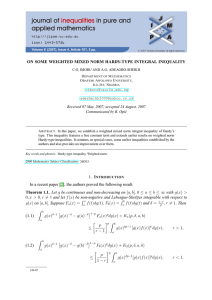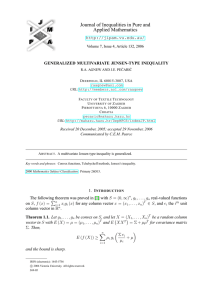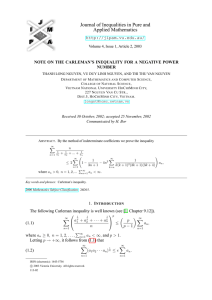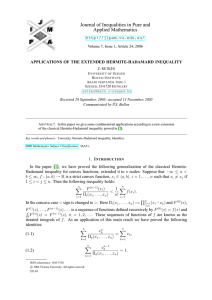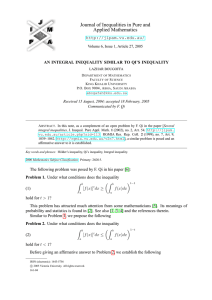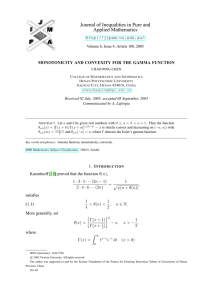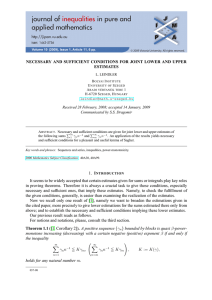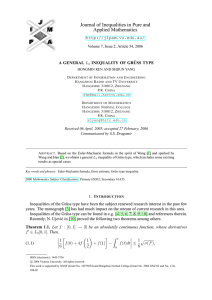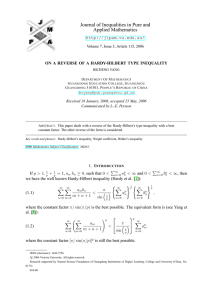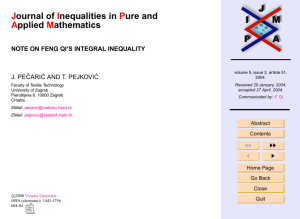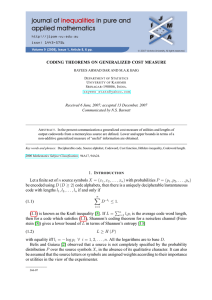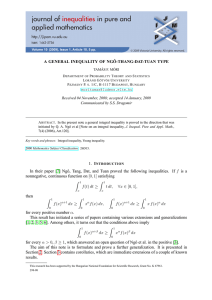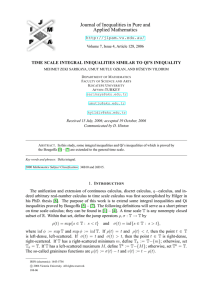TURÁN-TYPE INEQUALITIES FOR SOME Communicated by S.S. Dragomir
advertisement
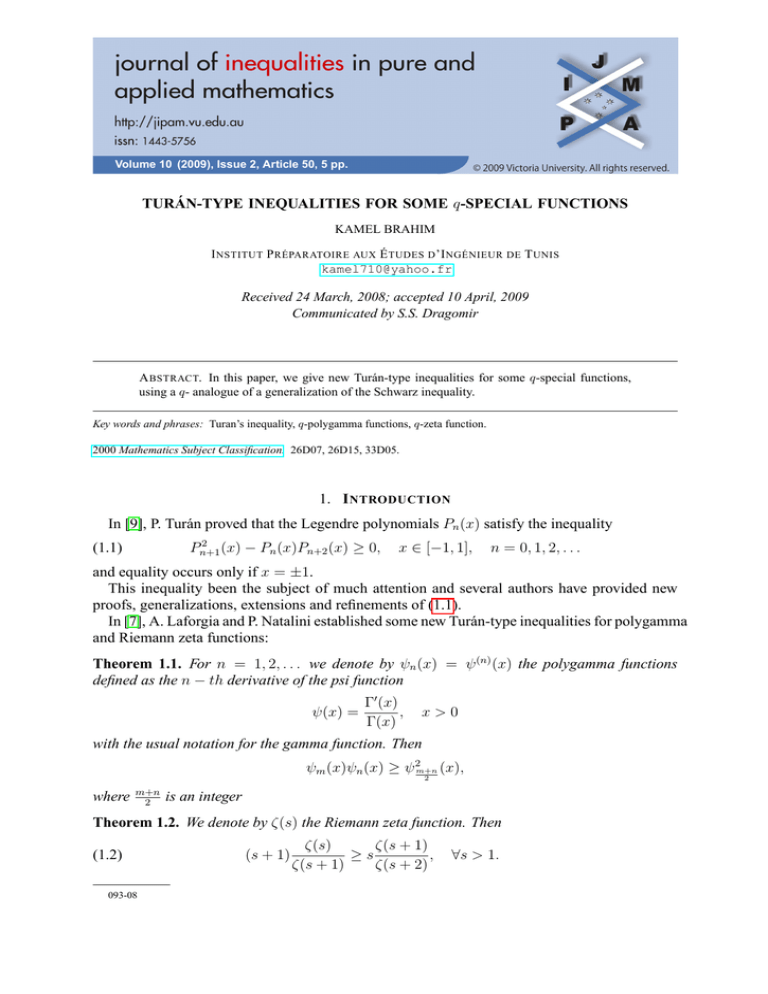
Volume 10 (2009), Issue 2, Article 50, 5 pp.
TURÁN-TYPE INEQUALITIES FOR SOME q-SPECIAL FUNCTIONS
KAMEL BRAHIM
I NSTITUT P RÉPARATOIRE AUX É TUDES D ’I NGÉNIEUR DE T UNIS
kamel710@yahoo.fr
Received 24 March, 2008; accepted 10 April, 2009
Communicated by S.S. Dragomir
A BSTRACT. In this paper, we give new Turán-type inequalities for some q-special functions,
using a q- analogue of a generalization of the Schwarz inequality.
Key words and phrases: Turan’s inequality, q-polygamma functions, q-zeta function.
2000 Mathematics Subject Classification. 26D07, 26D15, 33D05.
1. I NTRODUCTION
In [9], P. Turán proved that the Legendre polynomials Pn (x) satisfy the inequality
2
Pn+1
(x) − Pn (x)Pn+2 (x) ≥ 0,
(1.1)
x ∈ [−1, 1],
n = 0, 1, 2, . . .
and equality occurs only if x = ±1.
This inequality been the subject of much attention and several authors have provided new
proofs, generalizations, extensions and refinements of (1.1).
In [7], A. Laforgia and P. Natalini established some new Turán-type inequalities for polygamma
and Riemann zeta functions:
Theorem 1.1. For n = 1, 2, . . . we denote by ψn (x) = ψ (n) (x) the polygamma functions
defined as the n − th derivative of the psi function
ψ(x) =
Γ0 (x)
,
Γ(x)
x>0
with the usual notation for the gamma function. Then
ψm (x)ψn (x) ≥ ψ 2m+n (x),
2
where
m+n
2
is an integer
Theorem 1.2. We denote by ζ(s) the Riemann zeta function. Then
(1.2)
093-08
(s + 1)
ζ(s)
ζ(s + 1)
≥s
,
ζ(s + 1)
ζ(s + 2)
∀s > 1.
2
K. B RAHIM
The main aim of this paper is to give some new Turán-type inequalities for the q-polygamma
and q-zeta [2] functions by using a q-analogue of the generalization of the Schwarz inequality.
To make the paper more self contained we begin by giving some usual notions and notations
used in q-theory. Throughout this paper we will fix q ∈]0, 1[ and adapt the notations of the
Gasper-Rahman book [4].
Let a be a complex number, the q-shifted factorial are defined by:
(1.3)
(a; q)0 = 1;
(a; q)n =
n−1
Y
(1 − aq k )
n = 1, 2, . . .
k=0
(a; q)∞ = lim (a; q)n =
(1.4)
n→+∞
∞
Y
(1 − aq k ).
k=0
For x complex we denote
1 − qx
(1.5)
[x]q =
.
1−q
The q-Jackson integrals from 0 to a and from 0 to ∞ are defined by [4, 5]:
Z a
∞
X
(1.6)
f (x)dq x = (1 − q)a
f (aq n )q n
0
n=0
and
∞
X
∞
Z
f (x)dq x = (1 − q)
(1.7)
0
f (q n )q n
n=−∞
provided the sums converge absolutely.
Jackson [5] defined the q-analogue of the Gamma function as:
Γq (x) =
(1.8)
(q; q)∞
(1 − q)1−x
(q x ; q)∞
x 6= 0, −1, −2, . . . .
It satisfies the functional equation:
Γq (x + 1) = [x]q Γq (x),
(1.9)
Γq (1) = 1
and tends to Γ(x) when q tends to 1.
Moreover, it has the q-integral representation (see [1, 3])
Z ∞
Γq (s) = Kq (s)
xs−1 e−x
q dq x,
0
where
exq =
and
Kq (t) =
1
,
((1 − q)x; q)∞
(1 − q)−s
(−(1 − q), q)∞ (−(1 − q)−1 , q)∞
·
.
1 + (1 − q)−1 (−(1 − q)q s , q)∞ (−(1 − q)−1 q 1−s , q)∞
Lemma 1.3. Let a ∈ R+ ∪ {∞} and let f and g be two nonnegative functions. Then
2 Z a
Z a
Z a
m+n
m
n
g(x)f (x)dq x
g(x)f (x)dq x ,
(1.10)
g(x)f 2 (x)dq x ≤
0
0
0
where m and n belong to a set S of real numbers, such that the integrals (1.10) exist.
J. Inequal. Pure and Appl. Math., 10(2) (2009), Art. 50, 5 pp.
http://jipam.vu.edu.au/
T URÁN -T YPE I NEQUALITIES
3
Proof. Letting a > 0, by definition of the q-Jackson integral, we have
Z a
∞
X
m+n
m+n
(1.11)
g(x)f 2 (x)dq x = (1 − q)a
g(aq p )f 2 (aq p )q p
0
p=0
= lim (1 − q)a
N →+∞
N
X
g(aq p )f
m+n
2
(aq p )q p
p=0
By the use of the Schwarz inequality for finite sums, we obtain
!2
! N
!
N
N
X
X
X
m+n
(1.12)
g(aq p )f 2 (aq p )q p
≤
g(aq p )f m (aq p )q p
g(aq p )f n (aq p )q p .
p=0
p=0
p=0
The result follows from the relation (1.11) and (1.12).
To obtain the inequality for a = ∞, it suffices to write the inequality (1.10) for a = q −N ,
then tend N to ∞.
2. T HE q-P OLYGAMMA F UNCTIONS
The q-analogue of the psi function ψ(x) =
the q-gamma function, ψq (x) =
From (1.8), we get for x > 0
Γ0 (x)
Γ(x)
is defined as the logarithmic derivative of
Γ0q (x)
.
Γq (x)
ψq (x) = − Log(1 − q) + Log q
= − Log(1 − q) + Log q
∞
X
n=0
∞
X
n=1
q n+x
1 − q n+x
q nx
.
1 − qn
The last equality implies that
Log q
ψq (x) = − Log(1 − q) +
1−q
(2.1)
Z
0
q
tx−1
dq t.
1−t
(n)
Theorem 2.1. For n = 1, 2, . . . , put ψq,n = ψq the n-th derivative of the function ψq . Then
2
ψq,n (x)ψq,m (x) ≥ ψq,
m+n (x),
(2.2)
2
where
m+n
2
is an integer.
Proof. Let m and n be two integers of the same parity.
From the relation (2.1) we deduce that
Z
Log q q (Log t)n tx−1
ψq,n (x) =
dq t.
1−q 0
1−t
x−1
Applying Lemma 1.3 with g(t) = t1−t , f (t) = (− Log t) and a = q, we obtain
Z q x−1
2
Z q x−1
Z q x−1
m+n
t
t
t
n
m
2
(2.3)
dq t ,
(− Log t) dq t
(− Log t) dq t ≥
(− Log t)
0 1−t
0 1−t
0 1−t
which gives, since m + n is even,
(2.4)
2
ψq,n (x)ψq,m (x) ≥ ψq,
m+n (x).
2
J. Inequal. Pure and Appl. Math., 10(2) (2009), Art. 50, 5 pp.
http://jipam.vu.edu.au/
4
K. B RAHIM
Taking m = n + 2, one obtains:
Corollary 2.2. For all x > 0 we have
ψq,n (x)
ψq,n+1 (x)
≥
,
ψq,n+1 (x)
ψq,n+2 (x)
(2.5)
n = 1, 2, . . . .
3. T HE q- Z ETA FUNCTION
For x > 0, we put
Log(x)
−E
α(x) =
Log(q)
and
{x}q =
Log(x)
Log(q)
[x]q
q x+α([x]q )
,
where E Log(x)
is the integer part of Log(x)
.
Log(q)
Log(q)
In [2], the authors defined the q-Zeta function as follows
∞
∞
X
X
1
q (n+α([n]q ))s
(3.1)
ζq (s) =
=
.
{n}sq
[n]sq
n=1
n=1
They proved that it is a q-analogue of the classical Riemann Zeta function and we have for all
s ∈ C such that <(s) > 1,
Z ∞
1
ts−1 Zq (t)dq t,
ζq (s) =
e
Γq (s) 0
where for all t > 0,
Zq (t) =
∞
X
qt
e−{n}
q
n=1
eq (t) = Γq (t) .
and Γ
Kq (t)
Theorem 3.1. For all s > 1 we have
[s + 1]q
(3.2)
ζq (s)
ζq (s + 1)
≥ q[s]q
.
ζq (s + 1)
ζq (s + 2)
Proof. For s > 1 the function q-zeta satisfies the following relation
Z ∞
1
(3.3)
ζq (s) =
ts−1 Zq (t)dq t.
e
Γq (s) 0
Applying Lemma 1.3 with g(t) = Zq (t), f (t) = t we obtain
Z ∞
2
Z ∞
Z ∞
s−1
s+1
s
(3.4)
t Zq (t)dq t
t Zq (t)dq t ≥
t Zq (t)dq t .
0
0
0
Further, using (3.3), this inequality becomes
(3.5)
h
i2
eq (s)ζq (s + 2)Γ
eq (s + 2) ≥ [ζq (s + 1)]2 Γ
eq (s + 1) .
ζq (s)Γ
eq (s + 1) = q −s [s]q Γ
eq (s), we obtain
So, by using the relation Γ
(3.6)
[s + 1]q ζq (s)ζq (s + 2) ≥ q[s]q [ζq (s + 1)]2
which completes the proof.
J. Inequal. Pure and Appl. Math., 10(2) (2009), Art. 50, 5 pp.
http://jipam.vu.edu.au/
T URÁN -T YPE I NEQUALITIES
5
R EFERENCES
[1] A.De SOLE AND V.G. KAC, On integral representations of q-gamma and q-beta function, Atti Accad. Naz. Lincei Cl. Sci. Fis. Mat. Natur. Rend. Lincei Mat. Appl., 16(9) (2005), 11–29.
[2] A. FITOUHI, N. BETTAIBI AND K. BRAHIM, The Mellin transform in quantum calculus, Constructive Approximation, 23(3) (2006), 305–323.
[3] A. FITOUHI AND K. BRAHIM, Tauberian theorems in quantum calculus, J. Nonlinear Mathematical Physics, 14(3) (2007), 316–332.
[4] G. GASPER AND M. RAHMAN, Basic hypergeometric series, Encyclopedia of Mathematics and
its Applications, Vol. 35, Cambridge Univ. Press, Cambridge, UK, 1990.
[5] F.H. JACKSON, On a q-definite integral, Quarterly J. Pure and Appl. Math., 41 (1910), 193–203.
[6] V.G. KAC AND P. CHEUNG, Quantum Calculus, Universitext, Springer-Verlag, New York, 2002.
[7] A. LAFORGIA AND P. NATALINI, Turán -type inequalities for some special functions, J. Ineq.
Pure. App. Math., 7(1) (2006), Art. 22. [ONLINE: http://jipam.vu.edu.au/article.
php?sid=638]
[8] G. SZEGŐ, On an inequality of P. Turán concerning Legendre polynomials, Bull. Amer. Math. Soc.,
54 (1948), 401–405.
[9] P. TURÁN, On the zeros of the polynomials of Legendre, Casopis pro Pestovani Mat. a Fys, 75
(1950), 113–122.
J. Inequal. Pure and Appl. Math., 10(2) (2009), Art. 50, 5 pp.
http://jipam.vu.edu.au/




